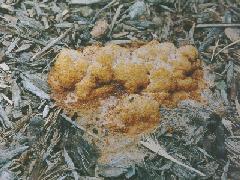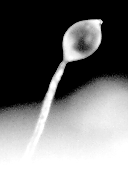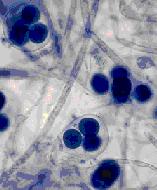Fungi-Like Protists
Fungi-Like Protists
Reminder: Clicking on the picture will take you to the site where I originally found it.
If you have producers and consusmers in a system, you've got to have decomposers as well. The fungi-like protists do their job well.
Because they are decomposers, they feed on dead or decomposing material. They do the clean-up work for other organisms. The best known of the fungal protists are the slime molds.
There are three main types of slime molds. There are plasmodial, cellular and water slime molds. Let's take a look at each of these.
 Some slime molds live easily on land. They live and grow in the damp, rotting places of the forest. These are plasmodial slime molds, or myxomycota. These guys are pretty cool 'cause they are a compilation of cells. Let me explain.
Some slime molds live easily on land. They live and grow in the damp, rotting places of the forest. These are plasmodial slime molds, or myxomycota. These guys are pretty cool 'cause they are a compilation of cells. Let me explain.
Imagine you build an apartment building and in each of the apartments lives a single person. Now picture that they like each other so much they rip the walls down that separate the apartments, leaving a big, hollow building with a whole lot of people in there.
Now imagine that the apartments are cells and the people are nuclei. Plasmodial slime molds have many nuclei, but only a single cell membrane. The nuclei all function together, and they even divide at the same time. It's the ultimate in commune living.
To eat, a slime-mold engulfs food, just like an amoeba. If necessary, it can move. The plasmodium will live until it starts to dry out or starts to starve. If this happens, it moves to a new area. If conditions don't improve, it forms a stalk and releases spores. These spores are haploid, which means that this is how a slime mold reproduces sexually. These sex spores can remain inactive for long periods of time. When conditions are right, they take on an amoeba-like shape. They can also develop a flagellum, making them resemble sperm. When two of these gametes (the sex spores) get together, they form a new plasmodial slime mold.
 The cellular slime molds are almost opposite of the plasmodial slime molds. Cellular molds don't usually group up, but prefer to remain in their amoeba-like states. Comparatively, they're pretty boring, and they wouldn't even interest most scientists except something cool happens when they run out of bacteria to eat.
The cellular slime molds are almost opposite of the plasmodial slime molds. Cellular molds don't usually group up, but prefer to remain in their amoeba-like states. Comparatively, they're pretty boring, and they wouldn't even interest most scientists except something cool happens when they run out of bacteria to eat.
When conditions are bad, the cellular slime molds migrate toward each other. They blob together into a visible, mobile unit. This unit resembles a tower. The tower will grow, and if it's in a sunny spot, it will begin to dry out and form spores. If it is in shade, the tower falls over and begins to creep along the ground. It is now known as a slug. The slug will migrate until it finds a sunny spot with just the right conditions, and then it will fom a tower again, dry out and release spores.
.
 There are also water molds. Like its cousins, water molds can also reproduce sexually or asexually. These protists can be a big problem for humans. Some of these fungal protists are parasites, especially on plants. Some protists in the category have cool names like "downy mildew" or "phytophthora" which means "plant destroyer." One plant destroyer caused the great potato famine of Ireland (1846-7) which caused 800,000 people to die.
There are also water molds. Like its cousins, water molds can also reproduce sexually or asexually. These protists can be a big problem for humans. Some of these fungal protists are parasites, especially on plants. Some protists in the category have cool names like "downy mildew" or "phytophthora" which means "plant destroyer." One plant destroyer caused the great potato famine of Ireland (1846-7) which caused 800,000 people to die.
The water molds are a nuisance to valuable crops. The French almost lost all of their grapes one year to a water mold. Fortunately, they found a mixture of chemicals which killed the mold. This was the beginning of herbicide use to limit the effect of plant diseases.
Some fungi-like protists are so much like fungi that it's hard to draw the line. There is a group known as chytrids which are so simple, most scientists have included them in the protists. They are so much a part of the fungi kingdom that a few others have grouped them with the fungi. For no reason whatsoever, I placed them with the fungi, but be aware that some of the single-celled fungi rightly belong in with the protists.
Go back to the protists page,
back to the animal-like protists,
back to the plant-like protists, or
return to the overview.
 Some slime molds live easily on land. They live and grow in the damp, rotting places of the forest. These are plasmodial slime molds, or myxomycota. These guys are pretty cool 'cause they are a compilation of cells. Let me explain.
Some slime molds live easily on land. They live and grow in the damp, rotting places of the forest. These are plasmodial slime molds, or myxomycota. These guys are pretty cool 'cause they are a compilation of cells. Let me explain.
 The cellular slime molds are almost opposite of the plasmodial slime molds. Cellular molds don't usually group up, but prefer to remain in their amoeba-like states. Comparatively, they're pretty boring, and they wouldn't even interest most scientists except something cool happens when they run out of bacteria to eat.
The cellular slime molds are almost opposite of the plasmodial slime molds. Cellular molds don't usually group up, but prefer to remain in their amoeba-like states. Comparatively, they're pretty boring, and they wouldn't even interest most scientists except something cool happens when they run out of bacteria to eat. There are also water molds. Like its cousins, water molds can also reproduce sexually or asexually. These protists can be a big problem for humans. Some of these fungal protists are parasites, especially on plants. Some protists in the category have cool names like "downy mildew" or "phytophthora" which means "plant destroyer." One plant destroyer caused the great potato famine of Ireland (1846-7) which caused 800,000 people to die.
There are also water molds. Like its cousins, water molds can also reproduce sexually or asexually. These protists can be a big problem for humans. Some of these fungal protists are parasites, especially on plants. Some protists in the category have cool names like "downy mildew" or "phytophthora" which means "plant destroyer." One plant destroyer caused the great potato famine of Ireland (1846-7) which caused 800,000 people to die.